16 Mar 2021 - {{hitsCtrl.values.hits}}
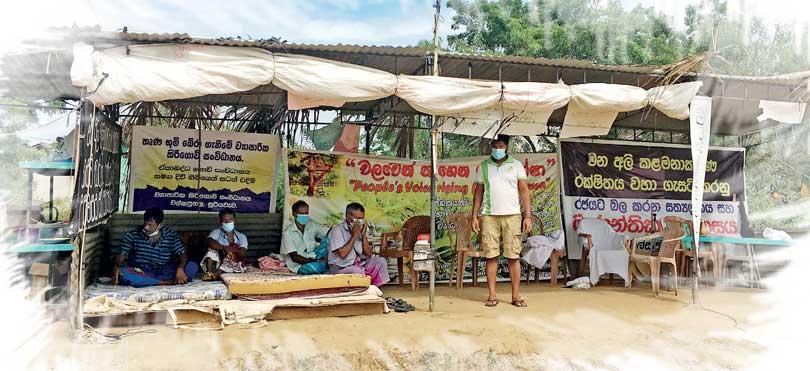
A section of farmers is seen here nudging the Government through a ‘Satyagraha’ to install an electric fence around the reserve instead of the existing one and to chase away elephants from lands utilised for cultivation purposes 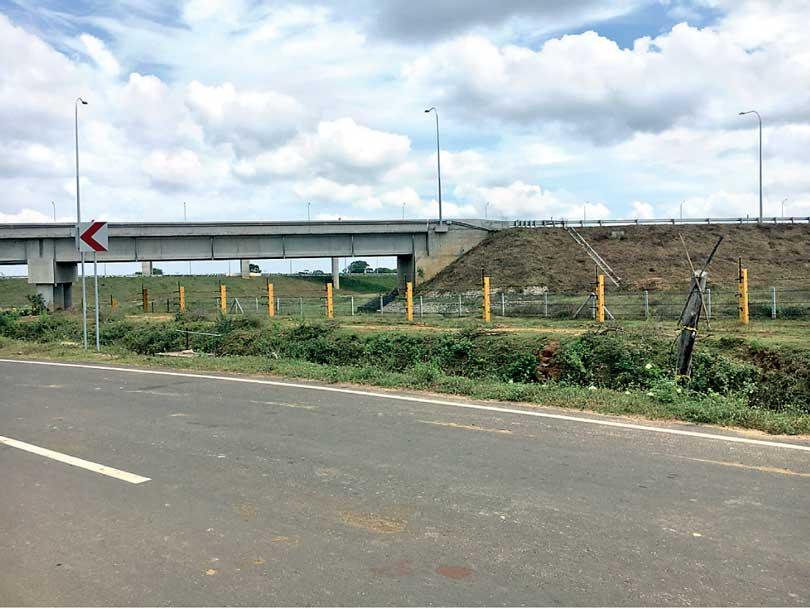
Part of the Southern Expressway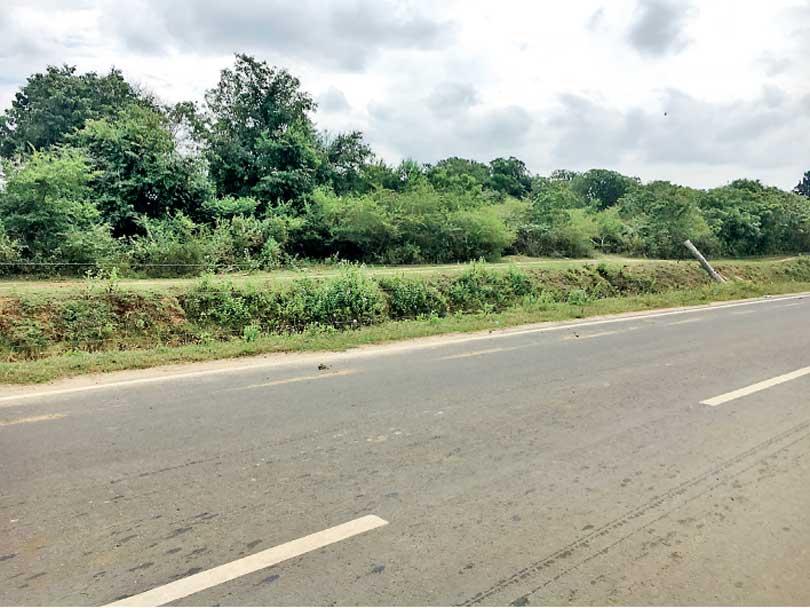 Around 450 elephants are said to be roaming within the MER
Around 450 elephants are said to be roaming within the MER
 Fifty eight (58) days have lapsed since farmers in Walsapugala, a grama niladhari division in Hambantota launched a satyagraha to call upon the government to protect their paddy lands. The human-elephant conflict (HEC) is a threat they have lived with for the greater part of their lives. But this conflict has aggravated as of late with mega scale development projects which are either in the pipeline or are currently underway. This is why around 86 farmer organisations in Hambantota collectively proposed the government to declare an extent of land connecting Udawalawa, Lunugamwehera and Bundala National Parks as a Managed Elephant Reserve (MER) so that their migratory routes are secured and elephants would keep away from moving into villages in search of food. However, the initial extent of land has now diminished as these lands fall under the purview of three institutions including the Mahaweli Authority, Forest Department and the Department of Wildlife Conservation (DWC).
Fifty eight (58) days have lapsed since farmers in Walsapugala, a grama niladhari division in Hambantota launched a satyagraha to call upon the government to protect their paddy lands. The human-elephant conflict (HEC) is a threat they have lived with for the greater part of their lives. But this conflict has aggravated as of late with mega scale development projects which are either in the pipeline or are currently underway. This is why around 86 farmer organisations in Hambantota collectively proposed the government to declare an extent of land connecting Udawalawa, Lunugamwehera and Bundala National Parks as a Managed Elephant Reserve (MER) so that their migratory routes are secured and elephants would keep away from moving into villages in search of food. However, the initial extent of land has now diminished as these lands fall under the purview of three institutions including the Mahaweli Authority, Forest Department and the Department of Wildlife Conservation (DWC).
Plight of the proposed Managed Elephant Reserve
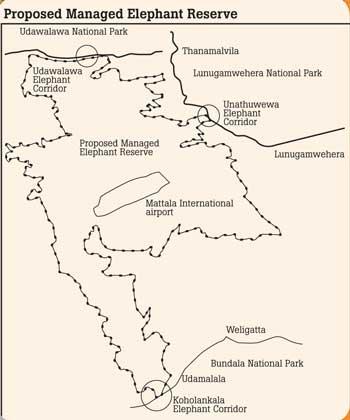 The proposed MER connects Udawalawa, Lunugamwehera and Bundala National Parks and protects habitats which are home to around 450 elephants. The idea was proposed in 2009 under the Gajamithuro Programme done by the DWC. Subsequently the proposal was approved in 2012 at the Gajamithuro District Committee meeting. But since there has been no progress on the project since then, three elephant corridors that were identified have now been disrupted due to human activities.
The proposed MER connects Udawalawa, Lunugamwehera and Bundala National Parks and protects habitats which are home to around 450 elephants. The idea was proposed in 2009 under the Gajamithuro Programme done by the DWC. Subsequently the proposal was approved in 2012 at the Gajamithuro District Committee meeting. But since there has been no progress on the project since then, three elephant corridors that were identified have now been disrupted due to human activities.
Even though no HEC related incidents have been reported from Unathuwewa, an alternative elephant migratory route was proposed near the 31-32 kilometre posts along the Udawalawa-Thanamalwila road. This route connects Udawalawe National Park and Lunugamwehera National Park via the Dahaiyagala elephant corridor. But as of late, Dahaiyagala too has been subject to mass scale destruction, further disrupting elephant corridors and habitats.
Furthermore, around 2000 acres have been cleared in between Maha Andara Wewa and Pahala Andara Wewa to be utilised for a banana cultivation. Around 600 acres have been cleared near Thissapura and Buruthankanda for solar power projects. Another 300 acres have been cleared above the Walsapugala – Diwulpelessa Lake for another mega scale solar power project. In addition, another 15,000 acres have been utilised for the Mattala Airport, Hambantota Harbour and the International Convention Centre. The Mahaweli Authority has allegedly released around 6000 acres from Kaaliyapura, Gannoruwa, Ketanwewa, Pahala Andara Wewa and Kuda Indi Wewa areas to be given away to private entities.
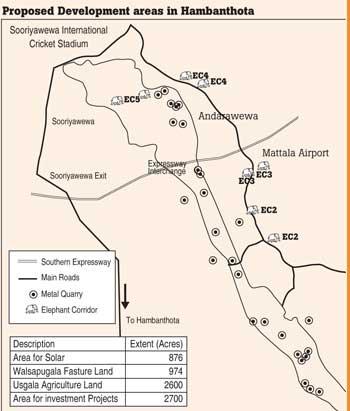 Around 40% of the land area that is being utilised for mega scale cultivation projects, illegal stone quarries and sand mining activities come under the purview of the Mahaweli Authority. As per the Mahaweli Authority Act No. 73 of 1979, section 3:1 even though a vast extent of land has been allocated for the development of the Walawe Left Bank, the Authority has no legal right to clear all lands in the area. With haphazard development activities taking place, sensitive habitats including the Madunagala Sanctuary, Karambagahamulla Herbal forest and Konketi Ara Forest that lie within the Mahaweli Authority land complex are now under threat.
Around 40% of the land area that is being utilised for mega scale cultivation projects, illegal stone quarries and sand mining activities come under the purview of the Mahaweli Authority. As per the Mahaweli Authority Act No. 73 of 1979, section 3:1 even though a vast extent of land has been allocated for the development of the Walawe Left Bank, the Authority has no legal right to clear all lands in the area. With haphazard development activities taking place, sensitive habitats including the Madunagala Sanctuary, Karambagahamulla Herbal forest and Konketi Ara Forest that lie within the Mahaweli Authority land complex are now under threat.
Likewise, the vast extent of land that has been proposed for the MER is diminishing by day and by night. Gazetting the MER will not only protect sensitive ecosystems that fall within this area, but as many as 38 lakes, marshlands, wetlands, habitats for migratory birds and several archeological sites too will be protected.
Farmers’ requests
In December 2020, the Daily Mirror reported on the projects happening with the MER and farmers in Walsapugala commenced a satyagraha on January 18, calling on the Government and authorities to fulfill several of their requests, one of them being a request to gazette the MER. Some of their other requests are:
Initially, around 25,000-30,000 hectares of the MER were to be gazetted, but now it has been reduced to around 12,500 hectares. Lands belonging to the Mahaweli Authority, Forest Department and Department of Wildlife Conservation, lie within this area and farmers believe that all these institutions should work together to solve the issues at hand. With mega scale cultivation projects, stone quarries and other private projects taking place within the Reserve, concerns have been raised as to how these projects would not disturb elephant routes and habitats.
Political blessings and corruption
“We have made several requests and they have only responded to gazetting the MER,” opined Mahinda Samarawickrama, leader of a farmer organisation in Hambantota . “But still it isn’t clear as to how this area is being gazetted and the regulations that would be in place. Around 65,000 acres were initially allocated for the MER. But 7000 acres have been reduced and we need to know from where and how it has been reduced. Most illegal projects are taking place within the MER. The Mahaweli Authority has filed cases against 13 people who have claimed ownership of around 1000 acres. It’s alleged that the Authority has been requested to remove the case. We also have an issue with regard to water. When large scale farmers get water, farmers outside the MER don’t have water for their cultivations,” said Samarawickrama.

But still it isn’t clear as to how this area is being gazetted and the regulations that would be in place. Around 65,000 acres were initially allocated for the MER. But 7000 acres have been reduced and we need to know from where and how it has been reduced
Mahinda Samarawickrama, leader of a farmer organisation in Hambantota
Another one of their requests is with regards to cattle farmers. “Cows graze on lake bunds and these bunds get destroyed. Therefore there has to be a separate land for cows to graze and the Authority promised to provide a land of around 2500 acres for this purpose. But this promise hasn’t been fulfilled. It was back in 2000 that lands were provided from the Walawe Left Bank project. Since the water capacity at Udawalawe Reservoir is limited the officials were of the stance that water cannot be provided to develop the left bank. Therefore they proposed a mechanism to provide water to individual lands via concrete ducts so that less water would be absorbed to the ground. Therefore a paddy land will receive 16 hours of water per week. Vegetables and fruit farmers will only get water for 14 hours. So farmers were educated on how to manage water and develop their cultivations. But at present large scale farmers are diverting this water towards their cultivations, both day and night. Not even the Mahaweli Authority is responding to this situation,” he added.
He further said that there are around 16 large scale farmers. “Many of them support local politicians. The Mahaweli Authority is responsible for the farmer families that have been resettled in that zone. If elephants destroy agriculture lands in the Mahaweli Development Zone, then the Authority should take actions to control the issue. Some lands within the MER are owned by the Mahaweli Authority, Forest Department and DWC. While the DWC is trying to protect the animals, the Authority is trying to sell everything to political henchmen,” Samarawickrama.
Speaking about the HEC in the area, Samarawickrama said that people in areas such as Weli Wewa, Meegahajandura, Galahitiya Wewa, Andara Wewa and Walsapugala succumbed to injuries in 2020. “Six elephants also died. For a year, the DWC allocates around 35 lakhs as compensation for one grama niladhari division and these include Ambalantota, Lunugamwehera, Hambantota, Sooriyawewa and Sewanagala. This sums up to around one million. If someone dies the family receives Rs. 500,000. When a house is damaged they would measure the area that is damaged and would pay compensation only for that damaged area,” he added.
The route proposed by farmers for the passage of elephants is via the Udawalawe Elephant Corridor and the Unathuwewa EC that connects the Lunugamwehera National Park and the MER. The elephants will then travel through the MER and exit from the Koholankala EC that connects the MER and the Bundala National Park. The Daily Mirror also learned that apart from the Mattala International Airport and a solar farm, many projects happening within the MER are either illegal or are large scale cultivations, further disrupting wildlife habitats.
Apart from that these regulations will also look at streamlining procedures related to activities happening within the MER. We are trying to link with other institutions to implement the process. A committee has also been appointed to look into the matter
DWC Director General Chandana Sooriyabandara
Regulations drafted, awaiting Legal Draftsman’s response
Prior to gazetting the MER we drafted the regulations and sent it to the legal draftsman’s office,” said DWC Director General Chandana Sooriyabandara. “We then have to respond to any queries.” he added.
When asked if the DWC would have a regulatory power over lands once the MER is gazetted, Sooriyabandara responded in the negative. “We somehow get an overall regulatory power sans the authority to regulate land-related matters. Apart from that these regulations will also look at streamlining procedures related to activities happening within the MER. We are trying to link with other institutions to implement the process. A committee has also been appointed to look into the matter.” said Sooriyabandara.
He further said that the gazette will be issued in approximately a month’s time.
No delays in
issuing gazette
We are also looking at safeguarding the lands of traditional chena cultivators. Around 200-300 acres are being dozered by machinery and these are not traditional agriculture lands. Therefore the Mahaweli Authority and the DWC is working in sync to put an end to illegal land grabbing attempts
in the areaMinister of Youth Affairs and Sports
Namal Rajapaksa
Even though Irrigation Minister Chamal Rajapaksa affirmed that the gazette would be issued within a month’s time back in February, there exists a delay in issuing the gazette. Responding to a query Minister of Youth Affairs and Sports Namal Rajapaksa said that there are no delays as such. “The proposal to gazette this area was initially suggested by me back in 2012 but once the government changed, everything was at a standstill.
“We are also looking at safeguarding the lands of traditional chena cultivators. Around 200-300 acres are being dozered by machinery and these are not traditional agriculture lands. Therefore the Mahaweli Authority and the DWC is working in sync to put an end to illegal land grabbing attempts in the area,” said
Namal Rajapaksa.
The farmers also pointed out that once the expressway was constructed, elephants were separated on either side of it. When asked about this allegation, Rajapaksa said that when the highway was built two wire ducts were maintained for elephants to cross. “But because elephants don’t cross on concrete, this has to be done with a vertical gardening concept. One of these wire ducts is 850 meters long while the other is 600 meters long. This is for elephants and all animals to cross. So we will be working with the Road Development Authority during the coming few months to implement this solution.”
When asked if Environmental Impact Assessments were done prior to implementing projects such as the Expressway and the Mattala Airport, Namal Rajapaksa responded in the affirmative while stating that it’s natural for certain disturbances to occur. “This is why we tried providing alternatives. When the airport was being constructed we put an electric fence near Bandagiriya Tank and kept the elephant corridor open, so that elephants could cross the tank. But now, illegal cultivators have started cultivating around the lake and elephants cannot cross it.” said Namal Rajapaksa.
He further said that the gazette will be issued within a few weeks time.
Several attempts to contact Mahaweli Authority Director General Keerthi B Kotagama
proved futile.
27 Nov 2024 7 minute ago
27 Nov 2024 27 minute ago
27 Nov 2024 1 hours ago
27 Nov 2024 1 hours ago
27 Nov 2024 1 hours ago